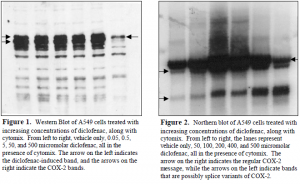Nathan K. Evanson and Dr. Daniel L. Simmons, Chemistry and Biochemistry
For many years, non-steroidal anti-inflammatory drugs (NSAIDs) have been used to treat pain, fever, and inflammation. The analgesic, antipyretic, and anti-inflammatory effects of these drugs have been attributed to the ability of these drugs to inhibit the activity of cyclooxygenase (COX) enzymes1. COX enzymes catalyze the rate-limiting step in the conversion of arachidonic acid (an unsaturated fatty acid) to potent signaling molecules called prostaglandins, which in turn mediate the inflammatory process. However, NSAIDs, such as diclofenac, have been reported to induce COX activity in certain cell lines2. These studies were done to determine whether a similar induction of COX in response to diclofenac could be reproduced in human cells.
The studies were performed using the A549 cell line, which originated from a human lung tumor. COX activity assays were performed by first plating cells onto 96-well plates and allowing them to grow to confluency. They were then treated for 24 hours with varying concentrations of the NSAID diclofenac, with and without a mixture of cytokines (10ng/ml each of interferon-gamma, tumor necrosis factor alpha and interleukin-1 beta, cytomix). The drugs were then removed and arachidonic acid was added to the cells. The concentration of prostaglandins produced by the cells was measured by radioimmunoassay. Cells treated in this same manner were also analyzed by the MTT(3-[4,5-Dimethylthiazol-2-yl]-2,5-diphenyltetrazolium bromide) assay to determine the extent of cell death caused by the treatments. The same treatments were performed on A549 cells grown in 6-well plates, and the cells were then scraped in triton X-100 extraction buffer and boiled in sample buffer. The protein samples thus obtained were analyzed by Western Blotting. Additionally, cells were grown in 10cm tissue culture plates and treated with diclofenac and cytomix, as the cells treated for Western Blotting, and RNA was extracted and analyzed by Northern Blotting.
It was found that cytomix alone greatly increases COX activity, but this activity was suppressed by even the smallest doses of diclofenac (less than 1 micromolar). No COX activity was ever observed in these cells after treatment with diclofenac at any concentration (data not shown). MTT assays showed that cells grew well in lower concentrations of diclofenac, but 500 micromolar treatments caused significant cell death. Western blotting showed COX protein being induced in the presence of diclofenac and cytomix. A549 cells, in the presence of cytomix, show the presence of 4 or 5 COX-2 bands, which are presumably different glycosylation states of COX-2, but in cells treated with 500 micromolar diclofenac, most of the COX-2 bands disappear and a single band that migrates between the two largest COX-2 bands appears (Figure 1). This band was apparently induced while regular COX-2 expression was suppressed by the high concentration of diclofenac. Northern blotting showed the presence of COX-2 mRNA in all treatments, in addition to two other bands, which are likely to be splice variants of COX-2 (Figure 2). The top band is the presumptive COX-2 messenger, and appears to be induced by lower concentrations of diclofenac, but suppressed in a measure by the higher concentrations of diclofenac. Also, the lowest band is apparently induced in a dose-dependent manner by diclofenac.
In A549 cells, then, COX-2 is induced by cytokines, but the induced COX-2 is very sensitive to inhibition by diclofenac. However, diclofenac does not inhibit production of COX-2 protein except at concentrations that cause cell death. At these high concentrations, regular COX-2 protein expression is inhibited and the expression of a variant of COX is produced. Diclofenac at this high concentration seems to inhibit the translation of COX-2, since the mRNA message is still present in the cells at concentrations sufficient to produce COX-2 protein. Elucidation of the biochemical pathways involved in this alteration of COX expression will be important in order to understand the full implications in the use of NSAIDs like diclofenac.

References
- Vane, J.r R. (1971) Nat. New Biol. 231, 232-35.
- Simmons, D. L. et al., Proc. Natl. Acad. Sci. USA, 96, 3275-80.
